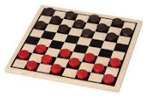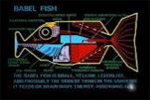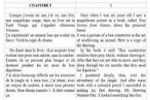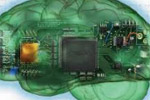Artificial Intelligence |
|
Umjetna inteligencija |
The destiny of artificial intelligence

|
|
Sudbina umjetne inteligencije

|
A new laboratory at Stanford

|
|
Novi laboratorij na Sveučilištu Stanford

|
The game of checkers

|
|
Igra dame

|
The weak solution

|
|
Slabo rješenje

|
The Babel Fish

|
|
Babilonska riba

|
Where do the bilingual texts come from?

|
|
Otkud dolaze dvojezični tekstovi?

|
AI in web search engines

|
|
Umjetna inteligencija kod internetskih tražilica

|
Computational intelligence is the manifest destiny of computer science

|
|
Računalna je inteligencija očita sudbina računalne znanosti

|
Artificial Intelligence |
top |
|
|
Umjetna inteligencija |
vrh |
|

The destiny of artificial intelligence
Artificial intelligence began with an ambitious research agenda: To endow machines with some of the traits we value most highly in ourselves - the faculty of reason, skill in solving problems, creativity, the capacity to learn from experience.
Early results were promising.
Computers were programmed to play checkers and chess, to prove theorems in geometry, to solve analogy puzzles from IQ tests, to recognize letters of the alphabet.
Marvin Minsky, one of the pioneers, declared in 1961: "We are on the threshold of an era that will be strongly influenced, and quite possibly dominated, by intelligent problem-solving machines".
Fifty years later, problem-solving machines are a familiar presence in daily life.
Computer programs suggest the best route through cross-town traffic, recommend movies you might like to see, recognize faces in photographs, transcribe your voicemail messages and translate documents from one language to another.
As for checkers and chess, computers are not merely good players; they are unbeatable...
 Search for more... Search for more...
Artificial intelligence began with an ambitious research agenda: To endow machines with some of the traits we value most highly in ourselves - the faculty of reason, skill in solving problems, creativity, the capacity to learn from experience.
Early results were promising.
Computers were programmed to play checkers and chess, to prove theorems in geometry, to solve analogy puzzles from IQ tests, to recognize letters of the alphabet.
Marvin Minsky, one of the pioneers, declared in 1961: "We are on the threshold of an era that will be strongly influenced, and quite possibly dominated, by intelligent problem-solving machines".
Fifty years later, problem-solving machines are a familiar presence in daily life.
Computer programs suggest the best route through cross-town traffic, recommend movies you might like to see, recognize faces in photographs, transcribe your voicemail messages and translate documents from one language to another.
As for checkers and chess, computers are not merely good players; they are unbeatable.
Even on the television quiz show Jeopardy, the best human contestants were trounced by a computer.
In spite of these achievements, the status of artificial intelligence remains unsettled.
We have many clever gadgets, but it's not at all clear they add up to a "thinking machine".
Their methods and inner mechanisms seem nothing like human mental processes.
Perhaps we should not be bragging about how smart our machines have become; rather, we should marvel at how much those machines accomplish without any genuine intelligence.
It is not only critics from outside the field who express such qualms about the direction of AI.
Fifteen years ago Minsky told an interviewer: "The bottom line is that we really haven't progressed too far toward a truly intelligent machine. We have collections of dumb specialists in small domains; the true majesty of general intelligence still awaits our attack".
At a recent mathematics meeting I heard Minsky offer a similar assessment, lamenting the neglect of the field's deepest long-range goals.
His comments prompted me to look back at the early literature of artificial intelligence, and then survey some of the recent accomplishments.
Has AI strayed from the true path, or has it found a better way forward?
» Search for more...
|
|

Sudbina umjetne inteligencije
Umjetna inteligencija počela je s ambicioznim istraživačkim programom: obdariti strojeve nekima od obilježja koja najviše cijenimo kod sebe samih – sposobnošću rasuđivanja, vještinom rješavanja problema, kreativnošću, sposobnošću učenja iz iskustva.
Rani rezultati bili su obećavajući.
Računala su bila programirana za igre poput dame i šaha, za dokazivanje poučaka iz geometrije, rješavanje analognih zagonetki iz testova inteligencije, prepoznavanje slova abecede.
Marvin Minsky, jedan od pionira, izjavio je 1961. godine: "Nalazimo se na pragu doba koje će možda biti pod snažnim utjecajem, a vrlo vjerojatno i dominacijom, inteligentnih strojeva za rješavanje problema".
Pedeset godina kasnije, strojevi za rješavanje problema postali su uobičajena pojava u svakodnevnom životu.
Računalni programi predlažu najbolji smjer kretanja kroz gradski promet, preporučuju filmove koje ćete možda htjeti pogledati, prepoznaju lica na fotografijama, zapisuju poruke vaše glasovne pošte i prevode dokumente s jednog jezika na drugi.
Što se tiče igara dame i šaha, računala nisu samo dobri igrači, već nepobjedivi...
 Potraži više... Potraži više...
Umjetna inteligencija počela je s ambicioznim istraživačkim programom: obdariti strojeve nekima od obilježja koja najviše cijenimo kod sebe samih – sposobnošću rasuđivanja, vještinom rješavanja problema, kreativnošću, sposobnošću učenja iz iskustva.
Rani rezultati bili su obećavajući.
Računala su bila programirana za igre poput dame i šaha, za dokazivanje poučaka iz geometrije, rješavanje analognih zagonetki iz testova inteligencije, prepoznavanje slova abecede.
Marvin Minsky, jedan od pionira, izjavio je 1961. godine: "Nalazimo se na pragu doba koje će možda biti pod snažnim utjecajem, a vrlo vjerojatno i dominacijom, inteligentnih strojeva za rješavanje problema".
Pedeset godina kasnije, strojevi za rješavanje problema postali su uobičajena pojava u svakodnevnom životu.
Računalni programi predlažu najbolji smjer kretanja kroz gradski promet, preporučuju filmove koje ćete možda htjeti pogledati, prepoznaju lica na fotografijama, zapisuju poruke vaše glasovne pošte i prevode dokumente s jednog jezika na drugi.
Što se tiče igara dame i šaha, računala nisu samo dobri igrači, već nepobjedivi.
Čak i na televizijskom kvizu Izazov, najbolje ljudske natjecatelje potuklo je računalo.
Usprkos tim postignućima, status umjetne inteligencije još je neodređen.
Imamo mnoge pametne naprave, ali nipošto nije jasno upućuju li one na "misleći stroj".
Njihove metode i unutarnji mehanizmi nisu ni slični ljudskim mentalnim procesima.
Možda se ne bismo trebali hvaliti kako su pametni naši strojevi postali; zapravo bismo se trebali diviti koliko ti strojevi postižu bez prave inteligencije.
Takve sumnje u smjer kojim se kreće umjetna inteligencija ne izražavaju samo kritičari izvan tog područja.
Prije petnaest godina Minsky je rekao voditelju intervjua: "Možemo zaključiti da zapravo nismo mnogo napredovali prema zaista inteligentnom stroju. Imamo skupove glupavih specijalista za uska područja; istinsku veličanstvenost opće inteligencije još uvijek nismo ni pokušali svladati".
Na nedavnom sastanku matematičara čuo sam sličnu Minskyjevu ocjenu - jadao se zbog zanemarivanja najbitnijih dugoročnih ciljeva na tom području.
Njegove su me primjedbe potakle da se vratim na ranu literaturu o umjetnoj inteligenciji, a zatim istražim neka od posljednjih dostignuća.
Je li umjetna inteligencija skrenula s pravog puta ili je otkrila bolji put napretka?
» Potraži više...
|

A new laboratory at Stanford
At the outset, research in artificial intelligence was the project of a very small community.
An inaugural conference in 1956 had just 10 participants.
They included Allen Newell and Herbert Simon of Carnegie Tech (now Carnegie Mellon University); Minsky, who had just begun his career at MIT; and John McCarthy, who left MIT to start a new laboratory at Stanford.
A major share of the early work in AI was done by these four individuals and their students.
It was a small community, but big enough for schisms and factional strife.
One early conflict pitted "the neats" against "the scruffies".
The neats emphasized the role of deductive logic; the scruffies embraced other modes of problem-solving, such as analogy, metaphor and reasoning from example.
McCarthy was a neat, Minsky a scruffy.
An even older and deeper rift divides the "symbolic" and the "connectionist" approaches to artificial intelligence.
Are the basic atoms of thought ideas, propositions and other such abstractions?
Or is thought something that emerges from patterns of activity in neural networks?
In other words, is the proper object of study the mind or the brain?
If an artificial intelligence needs a brain, maybe it also needs a body, with sensors that connect it to the physical world; thus AI becomes a branch of robotics...
 Search for more... Search for more...
|
|

Novi laboratorij na Sveučilištu Stanford
Na početku je istraživanje umjetne inteligencije bio projekt vrlo male zajednice.
Na predstavljanju 1956. godine bilo je samo 10 sudionika.
Među njima su bili Allen Newell i Herbert Simon sa Sveučilišta Carnegie Tech (sada Sveučilište Carnegie Mellon); Minsky, koji je tek bio započeo karijeru na MIT-u; i John McCarthy, koji je napustio MIT kako bi pokrenuo novi laboratorij na Sveučilištu Stanford.
Veći dio ranog istraživanja umjetne inteligencije obavila su ta četiri pojedinca sa svojim studentima.
Bila je to mala zajednica koja je ipak bila dovoljno velika za raskole i frakcijske borbe.
U jednom od ranih sukoba suprotstavili su se "uredni" i "razbarušeni".
Uredni su naglašavali ulogu deduktivne logike; razbarušeni su prigrlili druge načine rješavanja problema, poput analogije, metafore i rasuđivanja na temelju primjera.
McCarthy je bio uredan, a Minsky razbarušen.
Još stariji i dublji jaz razdvaja "simboličke" i "konekcionističke" pristupe umjetnoj inteligenciji.
Jesu li osnovni atomi misli ideje, tvrdnje i druge takve apstrakcije?
Ili je misao nešto što proizlazi iz obrazaca aktivnosti u neuralnim mrežama?
Drugim riječima, je li prikladan objekt istraživanja um ili mozak?
Ako je za umjetnu inteligenciju potreban mozak, možda je potrebno i tijelo, s osjetnicima koji ga povezuju s fizičkim svijetom; prema tome umjetna inteligencija postaje grana robotike...
 Potraži više... Potraži više...
|

The game of checkers
The game of checkers was the subject of one of the earliest AI success stories.
Arthur Samuel of IBM started work on a checkers-playing program in the early 1950s and returned to the project several times over the next 20 years.
The program was noteworthy not only for playing reasonably well - quite early on, it began beating its creator - but also for learning the game in much the same way that people do.
It played against various opponents (including itself!) and drew lessons from its own wins and losses.
Samuel explained the program's operation in terms of goals and sub-goals.
The overall goal was to reach a winning position, where the opponent has no legal move.
The program identified sub-goals that would mark progress toward the goal.
Experienced players pointed out that the program's main weakness was the lack of any sustained strategy or "deep objective".
The subsequent history of computer checkers is dominated by the work of Jonathan Schaeffer and his colleagues at the University of Alberta...
 Search for more... Search for more...
|
|

Igra dame
Igra dame bila je predmet jedne od prvih priča o uspjehu umjetne inteligencije.
Arthur Samuel iz IBM-a započeo je s radom na programu koji igra damu ranih 1950-ih i vraćao se projektu više puta tijekom sljedećih 20 godina.
Program je bio značajan ne samo po tome što je dosta dobro igrao - prilično rano je počeo pobjeđivati svog tvorca - već i po tome što je naučio igru na podjednak način na koji to čine ljudi.
Igrao je s raznim protivnicima (uključujući sebe!) i učio iz vlastitih pobjeda i poraza.
Samuel je rad programa objasnio u smislu ciljeva i podciljeva.
Ukupni cilj bio je postići pobjednički položaj, u kojem protivnik nema dopuštenog poteza.
Program je odredio podciljeve koji bi obilježili napredak prema cilju.
Iskusni igrači istaknuli su da je glavna slabost programa nedostatak kontinuirane strategije ili "dubljeg cilja".
Kasnijom poviješću računalnih igara dame dominirao je rad Jonathana Schaeffera i njegovih kolega sa Sveučilišta Alberta...
 Potraži više... Potraži više...
|

The weak solution
More recently, Schaeffer and his colleagues have gone on from creating strong checkers players to solving the game altogether.
After a series of computations that ended in 2007, they declared that checkers is "weakly solved".
The weak solution identifies a provably optimal line of play from the starting position to the end - which turns out to be a draw.
Neither player can improve his or her (or its) outcome by departing from this canonical sequence of moves.
(A "strong" solution would give the correct line of play from any legally reachable board position).
By the time this proof was completed, the endgame database encompassed all positions with 10 or fewer pieces (almost 40 trillion of them).
Schaeffer notes that his checkers-playing program doesn't need to know much about checkers...
 Search for more... Search for more...
|
|

Slabo rješenje
Nedavno su Schaeffer i njegovi kolege prešli sa stvaranja jakih igrača dame na rješavanje igre u cijelosti.
Nakon niza izračuna dovršenih 2007. godine, izjavili su da su došli do "slabog rješenja" dame.
Slabo rješenje definira dokazivo optimalan način igre od početnog položaja do kraja - a ispostavlja se da je on neodlučen.
Nijedan igrač ne može poboljšati svoj rezultat odstupajući od tog kanonskog niza poteza.
("Jako" rješenje dalo bi točan način igre sa svakog položaja na ploči u koji je dopušteno doći).
Do trenutka kompletiranja tog dokaza, baza podataka sa završecima igre obuhvaćala je sve položaje s 10 ili manje figura (njih gotovo 40 bilijuna).
Schaeffer napominje kako njegov program za igranje dame ne mora znati mnogo o dami...
 Potraži više... Potraži više...
|

The Babel Fish
In "The Hitchhiker's Guide to the Galaxy", Douglas Adams introduces the Babel Fish: "If you stick one in your ear, you can instantly understand anything said to you in any form of language".
Here in our little corner of the galaxy, Babel Fish is the name of a web service (part of Yahoo) that also performs translation, though it's limited to languages from Planet Earth.
Google and Microsoft offer similar services.
Depending on your needs and expectations, the quality of the results can seem either amazing or risible.
Efforts to build a translation machine were already under way in the 1950s.
The simplest of the early schemes was essentially an automated bilingual dictionary: The machine would read each word in the source text, look it up in the dictionary, and return the corresponding word or words in the target language.
The failure of this approach is sometimes dramatized with the tale of the English to Russian to English translation that began with "The spirit is willing but the flesh is weak" and ended with "The vodka is strong but the meat is rotten".
John Hutchins, in a history of machine translation, thoroughly debunks that story, but the fact remains that word-by-word dictionary lookup was eventually dismissed as useless...
 Search for more... Search for more...
|
|

Babilonska riba
U "Vodiču kroz galaksiju za autostopere" Douglas Adams predstavlja nam Babilonsku ribu: "Ako si je zabijete u uho, možete istog trena razumjeti sve što itko govori na bilo kojem jeziku".
Ovdje, u našem malom kutu galaksije, Babilonska riba (Babel Fish) naziv je internetske usluge (dijela Yahooa) koja također služi za prevođenje, samo što je ograničena na jezike s planeta Zemlje.
Google i Microsoft nude slične usluge.
Ovisno o tome što trebate i očekujete, rezultati vam se mogu činiti izvanrednima ili smiješnima.
Rad na razvoju stroja za prevođenje počeo je već 1950-ih godina.
Najjednostavniji od tih ranih sustava bio je u biti automatski dvojezični rječnik: stroj bi pročitao svaku riječ u izvornom tekstu, potražio je u rječniku i vratio odgovarajuću riječ ili riječi na ciljnom jeziku.
Neuspjeh tog pristupa ponekad se dramatizira pričom o prijevodu s engleskog na ruski pa opet na engleski koji je započeo rečenicom "The spirit is willing but the flesh is weak" ("Duh je voljan, ali tijelo je slabo"), a završio sa "The vodka is strong but the meat is rotten" ("Votka je jaka, ali meso je trulo").
John Hutchins, u svojoj povijesti strojnog prevođenja, u potpunosti prokazuje tu priču kao netočnu, ali ostaje činjenica da je pretraživanje rječnika riječ po riječ s vremenom odbačeno kao beskorisno...
 Potraži više... Potraži više...
|

Where do the bilingual texts come from?
Deliberately ignoring everything we know about grammar and meaning would seem to be a step backward.
However, all the information encoded in grammar rules and dictionary definitions is implicitly present in a large collection of texts; after all, that's where the grammarians and the lexicographers get it from in the first place.
Where do the bilingual texts come from?
Government bodies that publish official documents in two or more languages, such as Canada and the European Union, have been an important source.
Suppose you have a large corpus of parallel documents in French and English, broken down into pairs of matched sentences.
With this resource in hand, you are asked to provide an English translation of the French proverb.
Here is one way to begin: Take each word of the proverb, find all the French sentences in the corpus that include this word, retrieve the corresponding English sentences, and look for words that appear in these sentences with unusually high frequency.
In some cases the outcome of this process will be easy to interpret.
If a French sentence includes the word "chat", the English version is very likely to mention "cat".
Other cases could be equivocal.
The French word "craint" might be strongly correlated with several English words, such as "fears", "dreads" and "afraid".
And occasionally it might happen that no word stands out clearly...
 Search for more... Search for more...
|
|

Otkud dolaze dvojezični tekstovi?
Namjerno ignoriranje svega što znamo o gramatici i značenju čini se kao korak unatrag.
Međutim, sve informacije kodirane u gramatičkim pravilima i rječničkim definicijama implicitno su prisutne u velikoj zbirci tekstova; na kraju krajeva, tamo ih gramatičari i leksikografi i nalaze.
Otkud dolaze dvojezični tekstovi?
Državna tijela koja objavljuju službene dokumente na dvama ili više jezika, poput Kanade i Europske unije, važan su izvor.
Recimo da imate veliki korpus paralelnih dokumenata na francuskom i engleskom jeziku, podijeljen na parove podudarnih rečenica.
S takvim resursom na raspolaganju, od vas se traži da pružite engleski prijevod francuske poslovice.
Jedan od načina da započnete je sljedeći: uzmite svaku riječ poslovice, pronađite sve francuske rečenice u korpusu koje uključuju tu riječ, dobijte pripadajuće engleske rečenice i potražite riječi koje se pojavljuju u tim rečenicama neobično često.
U nekim slučajevima će rezultate tog procesa biti lako protumačiti.
Ako francuska rečenica uključuje riječ "chat", engleska verzija će vrlo vjerojatno spominjati "cat".
Drugi slučajevi mogu biti dvosmisleni.
Francuska riječ "craint" može biti čvrsto povezana s nekoliko engleskih riječi, poput "fears", "dreads" i "afraid".
A ponekad se može dogoditi da nema riječi koja se jasno ističe...
 Potraži više... Potraži više...
|

AI in web search engines
My final example comes from an area of AI where algorithmic ingenuity and high-performance computing have yet to triumph fully.
The task is to answer questions formulated in ordinary language.
In a sense, we already have an extraordinary question-answering technology: Web search engines such as Google and Bing put the world at our fingertips.
For the most part, however, search engines don't actually answer questions; they provide pointers to documents that might or might not supply an answer.
To put it another way, search engines are equipped to answer only one type of question: "Which documents on the Web mention X?", where X is the set of keywords you type into the search box.
The questions people really want to ask are much more varied.
One early experiment in question answering was a program called Baseball, written at MIT circa 1960, and the program was able to understand and answer questions such as "Who did the Red Sox lose to on July 5, 1960"?
This was an impressive feat at the time, but the domain of discourse was very small (a single season of professional baseball games) and the form of the queries was also highly constrained.
You couldn't ask, for example, "Which team won the most games"?..
 Search for more... Search for more...
|
|

Umjetna inteligencija kod internetskih tražilica
Moj zadnji primjer dolazi iz područja umjetne inteligencije u kojem algoritamska domišljatost i uporaba računala na visokoj razini tek trebaju u potpunosti trijumfirati.
Zadatak je davanje odgovora na pitanja formulirana običnim jezikom.
Na neki način već imamo izvanrednu tehnologiju za odgovaranje na pitanja: internetske tražilice poput Googlea i Binga stavljaju nam svijet na dohvat ruke.
Međutim, tražilice uglavnom zapravo ne odgovaraju na pitanja; pokazuju nam dokumente koji će nam možda pružiti odgovor, a možda i neće.
Drugim riječima, tražilice su opremljene za odgovor na samo jednu vrstu pitanja: "Koji dokumenti na mreži spominju X?", pri čemu je X skup ključnih riječi koje utipkate u okvir za pretraživanje.
Pitanja koja ljudi stvarno žele postaviti mnogo su raznolikija.
Jedan od ranih eksperimenata u odgovaranju na pitanja bio je program pod nazivom Baseball, napisan na MIT-u oko 1960. godine, i taj je program mogao razumjeti pitanja poput "Od koga su Red Soxi izgubili 5. srpnja 1960. godine?" i odgovoriti na njih.
To je bio dojmljiv pothvat u to vrijeme, ali područje diskursa bilo je vrlo usko (jedna sezona profesionalnog bejzbola) a oblik upita također je bio vrlo ograničen.
Niste mogli pitati, primjerice, "Koja je ekipa pobijedila u većini utakmica?"...
 Potraži više... Potraži više...
|

Computational intelligence is the manifest destiny of computer science
A bright spot on the question-answering horizon is Watson, the system created by David Ferrucci and a team from IBM and Carnegie Mellon to compete on Jeopardy.
The winning performance was dazzling.
On the other hand, even after reading Ferrucci's explanation of Watson's inner architecture, I don't really understand how it works.
In particular I don't know how much of its success came from semantic analysis and how much from shallower keyword matching or statistical techniques.
When Watson responded correctly to the clue "Even a broken one of these on your wall is right twice a day", was it reasoning about the properties of 12-hour clocks in a 24-hour world?
Or did it stumble upon the phrase "right twice a day" in a list of riddles that amuse eight-year-olds?
Writing in Nature last year, Etzioni remarked, "The main obstacle to the paradigm shift from information retrieval to question answering seems to be a curious lack of ambition and imagination".
I disagree.
I think the main obstacle is that keyword search, though roundabout and imprecise, has proved to be a remarkably effective way to discover stuff.
In the case of my baseball question, Google led me straight to the answer: On July 5,1960, the Red Sox lost to the Orioles, 9 to 4.
Once again, shallow methods that look only at the superficial structure of a problem seem to be outperforming deeper analysis...
 Search for more... Search for more...
|
|

Računalna je inteligencija očita sudbina računalne znanosti
Svijetla točka na obzoru odgovaranja na pitanja je Watson, sustav koji su kreirali David Ferrucci i tim iz IBM-a i s Carnegie Mellona za natjecanje u kvizu Izazov.
Pobjednički nastup je bio sjajan.
S druge strane, čak ni nakon čitanja Ferruccijevog objašnjenja Watsonove unutarnje arhitekture, ne razumijem zapravo kako on radi.
Konkretno, ne znam koliko je za njegov uspjeh zaslužna semantička analiza a koliko površne metode poput sparivanja ključnih riječi ili statistike.
Kad je Watson uzvratio točno na odgovor "Čak i ako onaj na vašem zidu ne radi, točan je dva puta dnevno", je li rasuđivao o osobinama 12-satne ure u 24-satnom svijetu?
Ili je naišao na frazu "točan je dva puta dnevno" u popisu zagonetaka za osmogodišnjake?
Pišući za Nature prošle godine, Etzioni je primijetio: "Čini se da je glavna prepreka promjeni paradigme iz dohvata podataka u odgovaranje na pitanja neobičan nedostatak ambicije i mašte".
Ne slažem se s time.
Mislim da je glavna prepreka to što se pretraživanje po ključnim riječima, iako je neizravno i neprecizno, pokazalo izvanredno učinkovitim načinom za otkrivanje stvari.
U slučaju mog bejzbolskog pitanja, Google me odveo ravno do odgovora: 5. srpnja 1960. godine Red Soxi su izgubili od Oriolesa s 9 prema 4.
Ponovo, čini se da su metode koje zanima samo površinska struktura problema učinkovitije od dublje analize...
 Potraži više... Potraži više...
|
|
|




